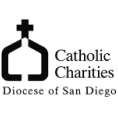
Bishop Statement
At the Diocese of San Diego, our pastoral offices provide a range of services to immigrants, from faith formation to workshops to conferences and more. The offices provide information and support in Spanish and Vietnamese, as well as in English. And through the Office for Ethnic and Intercultural Communities, the diocese assists and celebrates faith communities with roots in Africa, Asia, Europe and Latin America.
Upcoming Events
“May the grace of the Jubilee reawaken in us, Pilgrims of Hope, a yearning for the treasures of heaven...”
Emergency
Safety Plan
The Catholic Church in the United States is an immigrant Church with a long history of embracing diverse newcomers and providing assistance and pastoral care to immigrants, migrants, refugees, and people on the move. Our Church has responded to Christ’s call for us to “welcome the stranger among us,” for in this encounter with the immigrant, the migrant, and the refugee in our midst, we encounter Christ.

Resources
Lorem ipsum dolor sit amet, consectetur adipiscing elit. Ut elit tellus, luctus nec ullamcorper mattis, pulvinar dapibus leo.

Catholic Charities Diocese of San Diego
Lorem ipsum dolor sit amet, consectetur adipiscing elit. Sed sed accumsan urna. Sed sed lacus a nisi vehicula interdum ut a eros.

California Catholic Conference
Lorem ipsum dolor sit amet, consectetur adipiscing elit. Sed sed accumsan urna. Sed sed lacus a nisi vehicula interdum ut a eros.
An Immigrant Church
The Catholic Church in the United States is an immigrant Church with a long history of embracing diverse newcomers and providing assistance and pastoral care to immigrants, migrants, refugees, and people on the move. Our Church has responded to Christ’s call for us to “welcome the stranger among us,” for in this encounter with the immigrant, the migrant, and the refugee in our midst, we encounter Christ.
A rich body of Church teaching, including papal documents, bishops’ statements and pastoral letters, has consistently reinforced our moral obligation to treat the stranger as we would treat Christ himself.
In the Diocese of San Diego, virtually every nationality and culture is present. This diversity constitutes a powerful gift of the Holy Spirit palpably present in our midst. The diocese strives to foster a culture that celebrates diversity and unity equally in forging the Body of Christ.


Serving Immigrants
At the Diocese of San Diego, our pastoral offices provide a range of services to immigrants, from faith formation to workshops to conferences and more. The offices provide information and support in Spanish and Vietnamese, as well as in English. And through the Office for Ethnic and Intercultural Communities, the diocese assists and celebrates faith communities with roots in Africa, Asia, Europe and Latin America.
Catholic Charities Diocese of San Diego has taken a leadership role in recent years humanely receiving migrants legally in the country who are seeking asylum. The agency meets their most basic needs and assists them to reach their destination elsewhere in the country to await their day in court. The agency also assists refugees and immigrants who live in the region to establish themselves and to lead fruitful lives.
